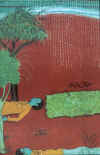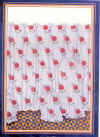| the-south-asian.com JANUARY 2002 | ||
| about us contact us data bank past issues the craft shop the print gallery | ||
|
JANUARY 2002 Contents Literature Pakistani
Literature Visual Arts South
Asian Art -
shared Rare
photographs of Indian Outlook Technology India
& China - major global Foreign
Investors in India's People Sports Books 'Knock
at Every Alien Door' Society
Books
|
Page 2 of 2
South Asian Art - negotiating a shared cultural frontier. (cntd) by Niilofur Farrukh Violence is a theme that haunts South Asian art as issues of gender equality, human rights and freedom of expression are all deeply entwined with creative expression. Each country has created its own narratives to communicate and combat these injustices. The post- independence art of Bangladesh was the catharsis that initiated an environment of healing. Today the Dhaka Biennale that was propelled by this energy has put Bangladesh on the global art map. Using the personal and the public as the warp and weft of its conceptual content, the art of South Asian with remarkable sensitivity and innovation chronicles is challenging social reality and dysfunctional politics. Public Art creates art strategies for the street and the people. A shrine for the dead and maimed at bomb blasts sites by Colombo artists helped focus on the human dimension of a tragedy that otherwise may have remained cold and distant like printed words, for most people. Instrumental in defusing communal tension, New Delhi based SAHMAT has worked with scholars and artists alike to highlight the historical significance of Babri Masjid in a traveling exhibition that challenges the official stand on the issue. In Karachi the Peace Action Committee sponsored Plaques for Peace, strive to give a voice to at least a million members of the silent majority that shuns war. As the definition of art is challenged every year by the contenders of UK"s controversial Turner Prize, so this year when it went to an empty room with a flickering bulb, the debate resumed with greater energy. Some called it buffoonery; akin to the antics of a court jester others termed the act to be full of wit. There was however an understanding among those who feel that the role of art is to make us look at the world with a new eye, which the creator of the flickering light has succeeded in doing. In our region, Installation art often receives the same confused response. From the canvas as art expands to creative space in cubic feet it leaves many bewildered. A sophisticated and versatile mode of communication, many an artist has begun to discover Installation Art’s potential to communicate with a growing audience that is partial to multiple sensory stimuli. While the Western installation artist often draws from his/her interface with technology the South Asian artist seldom makes technology the soul of his/her work and usually the interactive drama of personal, societal and communal conflict that finds its way to the core of these spatial spectacles. In a recent installation on the Afghan War, miniaturist Ayesha Khalid very effectively adapted her iconography of fabric patterns by using the green and khaki print of the combat uniform. Four pieces of the cloth were stretched on wooden hand embroidery frames. One piece had a big red rose embroidered on it and another one on a stand had vertical needles poised in the image of a rose. The menacing glint of their metal transformed it from tools of creating beauty to potential weapons. This subtle interplay hinted at the overt and covert politics of the conflict in a highly provocative way. Found objects, carefully fabricated objects, random sounds, music, movement, stillness, manipulated light all can dialogue in different configurations in Installation Art. The resultant montage of impressions seeks echoes in the human memory and the response becomes the entry point for the initiated and uninitiated alike to this new kind of art. The past and present converged in the installation ‘Remembering Toba Tek Singh’ a poignant play on the Partition of the Sub- Continent. The artist used television screens broadcasting news of communal riots. Taking its cue from the title, the images suggested a communal catastrophe foretold by the author through his protagonists. The cultural precinct of South Asia with its uninterrupted continuum of customs and belief systems is fertile with living traditions. Standing on the bedrock of its resilience and flexibility, here pluralism is a way of life and asymmetry its intellectual strength. The new aesthetic force that is evolving in this environment cannot be encapsulated in ‘isms’. It has its own dynamic energized by societal transformations and cultural imperatives peculiar to the people and their reality. As the South Asian thinker artist negotiates the shared parameters of this cultural zone, the barbed wire of politics once again stands to divide the people. Can one dare hope that just as economic interests have brought traditional foes together in Europe, creative strategies can be that cement, that unifies South Asian nations towards peace. NIILOFUR FARRUKH NEWSLINE ANNUAL JAN 2002 KARACHI
Copyright © 2000 - 2001 [the-south-asian.com]. Intellectual Property. All rights reserved. |
|


